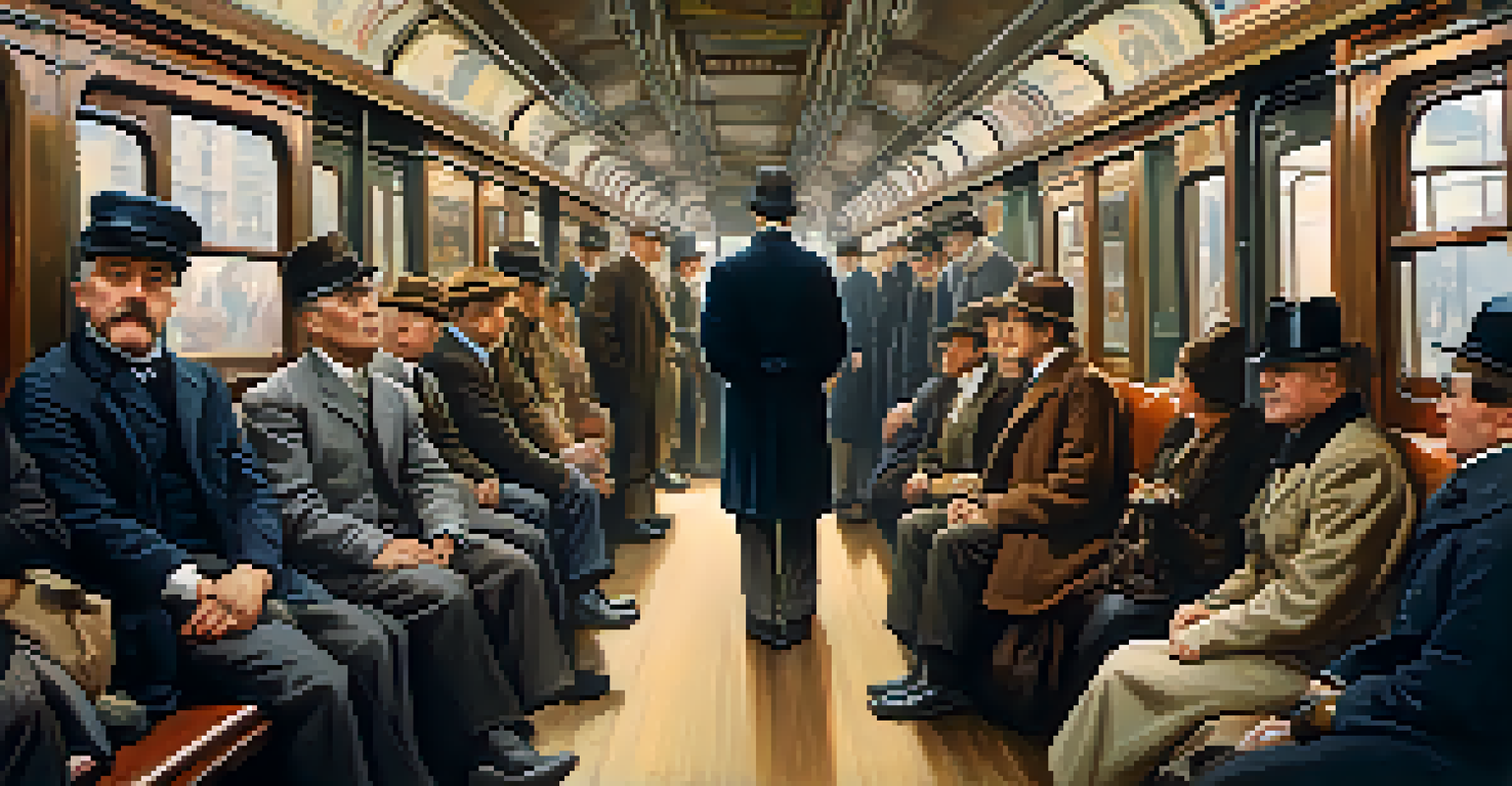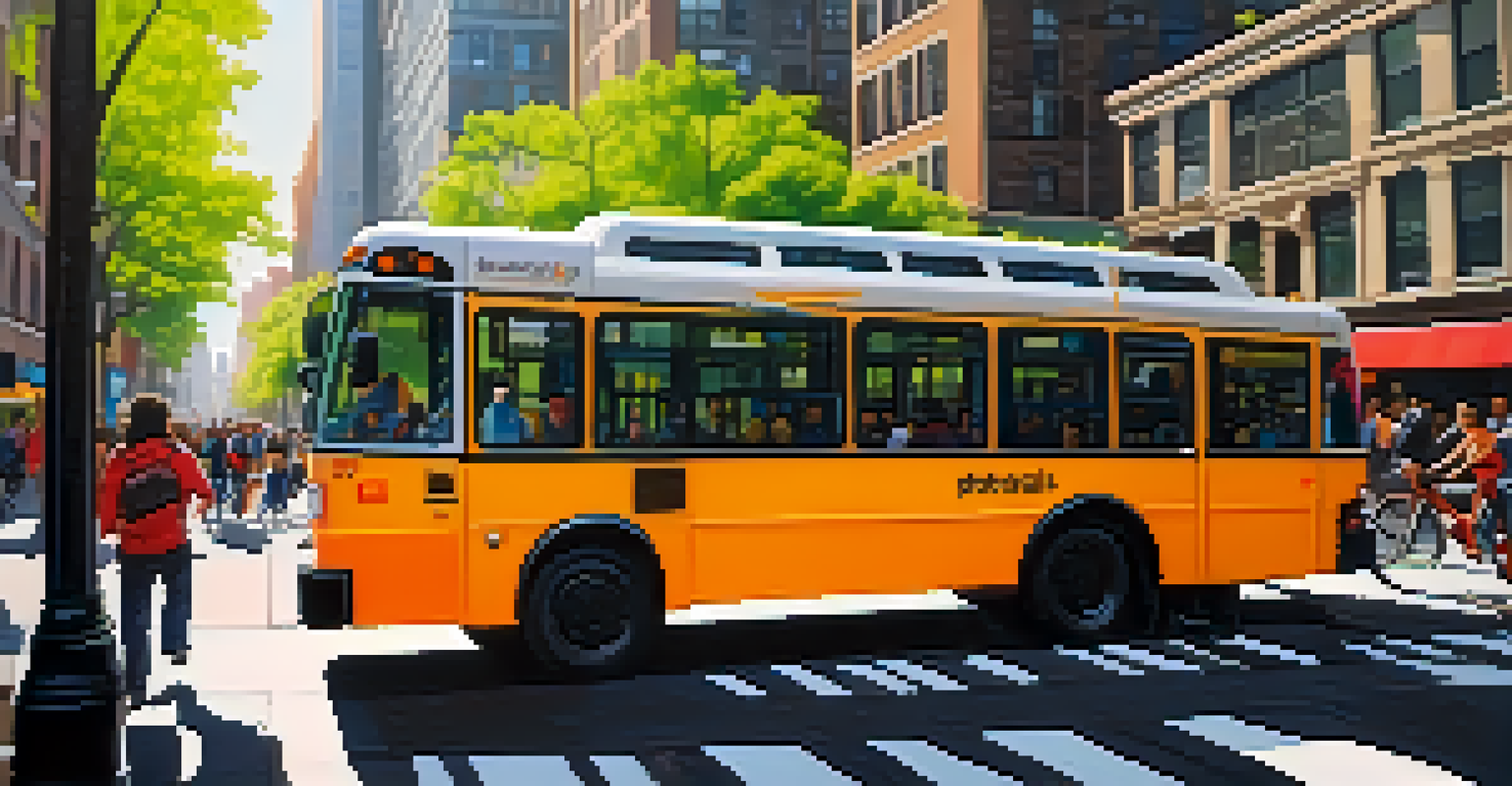The Evolution of Public Transit in New York City: A Timeline

The Birth of Public Transit in NYC: Early 19th Century
In the early 1800s, New York City began its journey toward organized public transit. Horse-drawn omnibuses started operating on city streets, providing a new way for residents to travel. These omnibuses marked the first attempts at a systematic means of transport, laying the groundwork for future developments.
Public transportation is the backbone of urban life; it connects people to opportunities and each other.
As the population grew, so did the demand for more efficient transport. In 1827, the first streetcars were introduced, powered by horses, which offered a more comfortable ride and increased capacity for passengers. This innovation captured the imagination of many New Yorkers, making public transit an essential part of urban life.
These early forms of public transit not only connected neighborhoods but also fostered a sense of community. The omnibuses and streetcars illustrated a shift toward a more interconnected city, showcasing the potential for public transportation to shape urban growth.
The Advent of the Subway System: Late 19th Century
As the city continued to expand, the limitations of surface transit became apparent. In response, the first underground subway line opened in 1904, forever changing the landscape of public transportation in New York. This groundbreaking innovation allowed for faster travel across greater distances, accommodating the burgeoning population.

The subway's introduction was a game-changer, making it possible for New Yorkers to live farther from their workplaces. This led to a population boom in outer boroughs and transformed the way people interacted with the city. Suddenly, neighborhoods that were once considered remote became accessible and vibrant.
Public Transit Evolution in NYC
New York City's public transit has evolved from horse-drawn omnibuses in the early 19th century to a complex subway system, significantly shaping urban life.
With the subway in full swing, New York City began to establish itself as a model for urban public transit systems worldwide. The success of the subway also paved the way for future expansions and improvements, setting a precedent that would influence transportation planning for generations.
Challenges of the Great Depression: 1930s
The Great Depression brought significant challenges to New York City's public transit system. Ridership plummeted as many lost their jobs and could no longer afford fares. This financial strain led to a series of fare hikes and service cuts, forcing the city to rethink its transit strategies.
The future of transportation is not about the cars we drive, but about the choices we make.
Despite these hardships, the 1930s also saw significant advancements in transportation infrastructure. The construction of the IND subway line began, aiming to alleviate overcrowding and enhance service. This ambitious project demonstrated a commitment to improving public transit, even in tough economic times.
The decade ultimately highlighted the resilience of the transit system and its integral role in the city’s recovery. As New Yorkers adapted to their circumstances, public transit continued to evolve, setting the stage for future growth and innovation.
Post-War Expansion and Modernization: 1940s-1960s
Following World War II, New York City's public transit system experienced a period of rapid expansion and modernization. The post-war economic boom led to increased investment in infrastructure, allowing for the development of new subway lines and bus routes. This expansion aimed to accommodate the growing population and the changing dynamics of urban life.
During this time, the city also began to address long-standing issues such as aging equipment and maintenance. The introduction of new technologies, including electric trains, helped improve service reliability and efficiency. Modernization efforts made public transit more appealing and accessible to a broader range of New Yorkers.
Community Advocacy Shapes Transit
During the 1970s and 1980s, community advocacy emerged as a crucial force in preserving and improving public transit services amid financial challenges.
However, this era was not without its challenges. As more residents acquired cars, public transit ridership began to decline, prompting a need for renewed focus on attracting passengers. City planners recognized the importance of public transportation in maintaining a sustainable urban environment, leading to innovative solutions in the following decades.
The Rise of Community Advocacy: 1970s-1980s
The 1970s marked a turning point for New York City's public transit as community advocacy groups began to emerge. These organizations worked tirelessly to address issues such as service cuts, fare increases, and deteriorating conditions. Their efforts highlighted the importance of public transit in the lives of everyday New Yorkers, pushing for accountability and improvements.
During this tumultuous time, the Metropolitan Transit Authority (MTA) faced significant financial challenges, leading to fare hikes and service reductions. However, the advocacy movements sparked a renewed interest in public transportation, emphasizing that it is a vital public service that should be accessible to all.
The grassroots campaigns not only influenced transit policies but also fostered a sense of ownership among residents. By actively participating in discussions and decisions regarding public transit, communities laid the groundwork for future improvements and enhancements, ensuring that their voices were heard.
Technological Innovations and Service Improvements: 1990s
The 1990s brought a wave of technological innovations that transformed New York City’s public transit system. The introduction of MetroCard in 1993 revolutionized fare collection, making it easier and more efficient for riders to pay. This shift not only streamlined the process but also encouraged increased ridership as it became more user-friendly.
In addition to fare technology, the city invested in modernizing its infrastructure. This included upgrading subway stations, improving signage, and enhancing accessibility for individuals with disabilities. These improvements aimed to create a more welcoming environment for all riders, ensuring that public transit could serve as a reliable option for everyone.
Focus on Sustainability and Resilience
In the 21st century, NYC's public transit is prioritizing sustainability and resilience, adapting to climate change and ensuring reliable service during emergencies.
The emphasis on technology and service improvements in the 1990s positioned New York City’s transit system as a leader in urban transportation. This era set the stage for ongoing enhancements that would continue well into the 21st century, reflecting the city's commitment to evolving with the needs of its residents.
Facing the Future: Sustainability and Resilience Initiatives
As we move into the 21st century, New York City’s public transit is increasingly focused on sustainability and resilience. The effects of climate change and urban congestion are prompting the MTA to explore greener options, such as electric buses and energy-efficient subway systems. This shift not only addresses environmental concerns but also recognizes the importance of sustainable urban planning.
In addition to sustainability, the transit system is prioritizing resilience against extreme weather events. Initiatives are being implemented to fortify infrastructure and ensure that public transportation remains reliable during storms and other emergencies. These efforts demonstrate a commitment to protecting both the system and the communities it serves.

Looking ahead, New York City's public transit is poised to continue evolving in response to the challenges of modern urban living. By embracing innovation, sustainability, and community involvement, the transit system can enhance its role as a lifeline for millions of New Yorkers, ensuring that it remains relevant for generations to come.